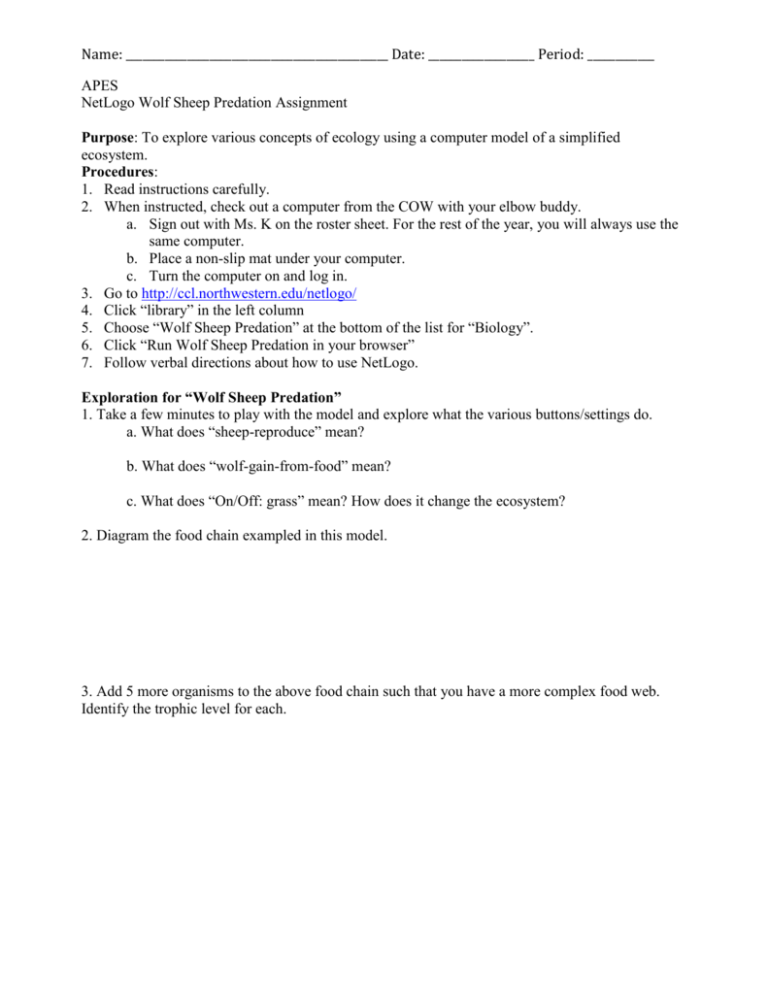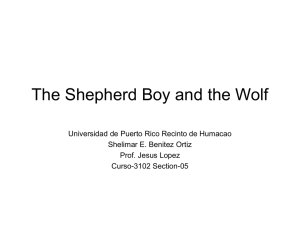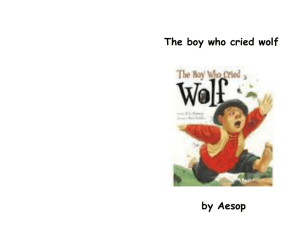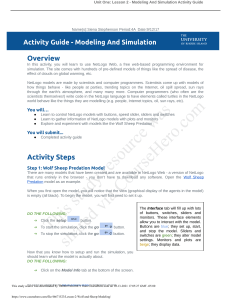Name: Date: Period: ______ APES NetLogo Wolf Sheep Predation
advertisement

Name: _______________________________________________ Date: ___________________ Period: ____________ APES NetLogo Wolf Sheep Predation Assignment Purpose: To explore various concepts of ecology using a computer model of a simplified ecosystem. Procedures: 1. Read instructions carefully. 2. When instructed, check out a computer from the COW with your elbow buddy. a. Sign out with Ms. K on the roster sheet. For the rest of the year, you will always use the same computer. b. Place a non-slip mat under your computer. c. Turn the computer on and log in. 3. Go to http://ccl.northwestern.edu/netlogo/ 4. Click “library” in the left column 5. Choose “Wolf Sheep Predation” at the bottom of the list for “Biology”. 6. Click “Run Wolf Sheep Predation in your browser” 7. Follow verbal directions about how to use NetLogo. Exploration for “Wolf Sheep Predation” 1. Take a few minutes to play with the model and explore what the various buttons/settings do. a. What does “sheep-reproduce” mean? b. What does “wolf-gain-from-food” mean? c. What does “On/Off: grass” mean? How does it change the ecosystem? 2. Diagram the food chain exampled in this model. 3. Add 5 more organisms to the above food chain such that you have a more complex food web. Identify the trophic level for each. Name: _______________________________________________ Date: ___________________ Period: ____________ 4. Run one round of the simulation using a setting that provides a sustainable population of grass, sheep, and wolves. a. Screen shot the settings and graph and paste below. b. Describe 3 patterns you see in the graph. Explain the patterns using your knowledge of the interaction between each organism. 5. Set “grass?” to off so that the only organisms in your model are the wolves and sheep. Adjust the settings and run a trial until you have an initial setting that results in a stable ecosystem. a. Screen shot the settings and graph and paste the below. b. Explain the setting and how the conditions of your model allow for a stable population of both organisms. Describe the resulting population. Was this difficult to achieve? Why do you think this was difficult to achieve? 6. Now set “initial-number-wolves” to 0 so that your ecosystem contains only grass and sheep. Adjust the settings and run a trial until you have an initial setting that results in a stable ecosystem. a. Screen shot the settings and graph and paste the below. b. Explain the setting and how the conditions of your model allow for a stable population of both organisms. Describe the resulting population. Was this difficult to achieve? Why do you think this was difficult to achieve? How did it compare to #5? 7. “show-energy” allows you to see how much “energy” the sheep and wolf have. a. What is this energy required for in the model? b. In real-life, what does an organism need energy for? What happens if an organism cannot meet its energy needs? c. What percent of usable energy is transferred as biomass from one trophic level to the next? What is this called? How does this limit the wolf and sheep population? 8. Choose an initial setting that you predict will maintain a maximum number of predators (wolves). a. Without running the model yet, screen shot the setting and copy below. Why do you think these setting will maintain a maximum number of predators? b. Run your model and describe the outcome. Why do you think this happened? 9. Choose an initial setting that you predict will maintain the most sustainable community. a. How does your prediction differ from #8? Why? b. Run your model and describe the outcome. Why do you think this happened? Name: _______________________________________________ Date: ___________________ Period: ____________ Post-lab questions 1. What flaws or inherent limitations do you see with the model that you explored? 2. Models such as these are a simplified version of what is mentioned in your textbook as “system analysis”. In this model, each organism is programmed with specific rules about how to interact with other organisms. If you were to modify “wolf sheep predation” to make it more accurately reflect the natural world, what other components would you add, and what relationships would you model? Name at least 2 modifications. For example, you might add water availability as a factor, and as time passes, have the amount of precipitation fluctuate. The grass might then be limited in growth by the availability of water, as will the sheep and wolf. 3. Name 5 biotic and abiotic factors that affect grass in a natural ecosystem. 4. What natural services does grass provide? 5. What other food chain can “Wolf Sheep Predation” be applied to? Why or how are these interactions similar? How are they different?








